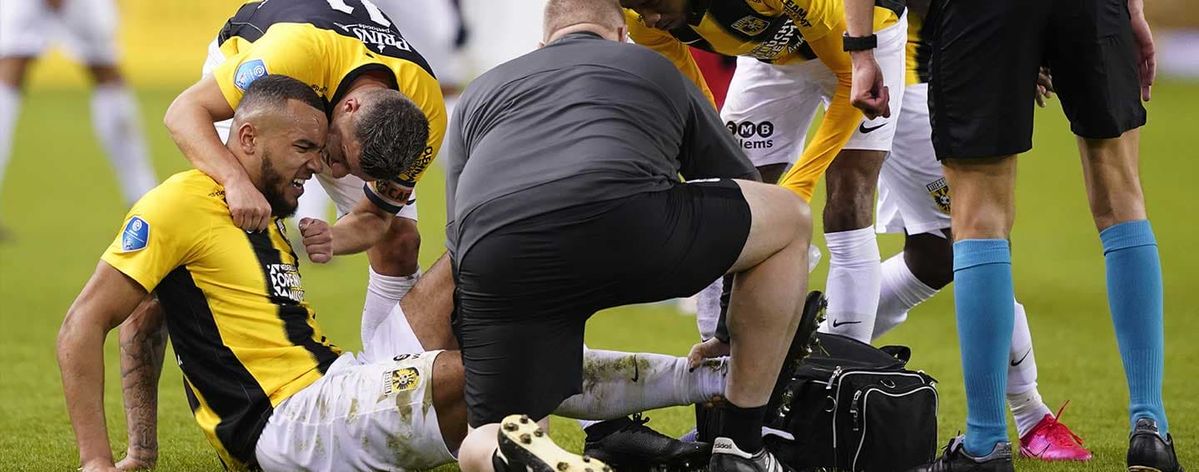Why Soccer Injury Prevention Matters
- High incidence rates: Soccer athletes experience frequent sprains, strains, and overuse injuries.
- Long-term impact: Recurring injuries can lead to chronic joint issues and extended time off-field.
- Financial & career cost: Recovery time, rehab expenses, and missed game opportunities all add up.
Most Common Soccer Injuries
1. Muscle Strains (Hamstrings, Quadriceps, Calf)
Rapid acceleration and deceleration put stress on muscle fibers—leading to strains and tears.
2. Ligament Injuries (ACL, MCL)
High-impact direction changes often strain knee ligaments, especially ACL and MCL.
3. Ankle Sprains
Twisting or rolling during play can damage ankle ligaments.
4. Concussions
Header duels and collisions may cause head trauma—requiring immediate evaluation.
5. Overuse Injuries (Shin splints, Tendinitis)
Frequent training without proper recovery may lead to chronic stress injuries.

Key Risk Factors for Soccer Injuries
- Poor or skipped warm-up
- Lack of flexibility and muscular strength
- Fatigue from overtraining
- Poor field conditions or low-quality footwear
Proven Soccer Injury Prevention Techniques
1. Dynamic Warm-Up Routines
A proper warm-up increases blood flow and prepares muscles for activity. Include exercises like leg swings, high knees, and hip openers for 10–15 minutes.
2. Strength and Conditioning
Building strength in the lower body, core, and glutes enhances stability and reduces injury risk. Include squats, lunges, planks, and resistance training.
3. Proper Stretching Techniques
Dynamic stretches are best before play, while static stretching aids recovery post-training. Focus on hamstrings, calves, hips, and groin.
4. Neuromuscular Training
Agility ladders, single-leg balance drills, and reaction training improve coordination and prevent non-contact injuries.
5. Rest and Recovery Strategies
Incorporate active recovery days, adequate sleep (7–9 hours), and techniques like foam rolling and massage to support healing.
Best Practices for Coaches and Parents
- Monitor training volume and avoid burnout
- Provide real-time feedback to improve player technique
- Ensure a safe, well-maintained training environment
- Encourage open communication about pain or discomfort
Equipment and Gear for Injury Prevention
- Cleats: Choose shoes that match the playing surface (firm ground, turf, or indoor).
- Shin guards: Must fit properly and cover the full shin.
- Mouthguards: Useful for preventing dental and jaw injuries during contact games.
- Field conditions: Regularly check for uneven surfaces, holes, and debris.
When to See a Sports Medicine Specialist
Ignoring injuries can lead to chronic issues. Seek professional help if you experience:
- Persistent pain or swelling
- Limited range of motion
- Recurrent injuries in the same area
- Difficulty walking or bearing weight
Always consult a licensed sports physician or physiotherapist for a proper diagnosis and recovery plan.
Expert Tips from Sports Trainers
Professional trainers emphasize prevention as a daily habit. Here are a few pro-level insights:
“Injury prevention starts with awareness. Every player, no matter the level, should treat their body like a professional.”
– Jake Reynolds, Certified Athletic Trainer
“Consistency in strength and mobility training cuts injuries by up to 40% over a season.”
– Dr. Amelia Ford, Sports Physiotherapist
Follow advice from credible trainers and always stay proactive with your conditioning routine.
FAQ: Soccer Injury Prevention
What’s the #1 cause of soccer injuries?
Poor warm-up and muscle imbalances are the top causes of preventable soccer injuries.
Are ankle braces effective for soccer players?
Yes, especially for players with a history of sprains. They offer stability and help reduce re-injury risk.
Can yoga help prevent soccer injuries?
Absolutely. Yoga enhances flexibility, balance, and muscular control—all vital for injury prevention.
How many rest days should young players take?
Youth players should have at least 1–2 full rest days per week to allow for muscle recovery and injury prevention.
Is taping or bracing better?
Both have benefits. Taping offers flexibility, while braces provide consistent support. Choice depends on personal preference and injury history.
Conclusion
Injury prevention is not just about avoiding pain—it’s about enhancing performance, longevity, and confidence on the field. By incorporating dynamic warm-ups, strength training, expert strategies, and proper recovery, you can significantly reduce injury risk and stay in peak condition all season.



0 responses to “Soccer Injury Prevention: Expert Tips to Stay Safe on the Field”